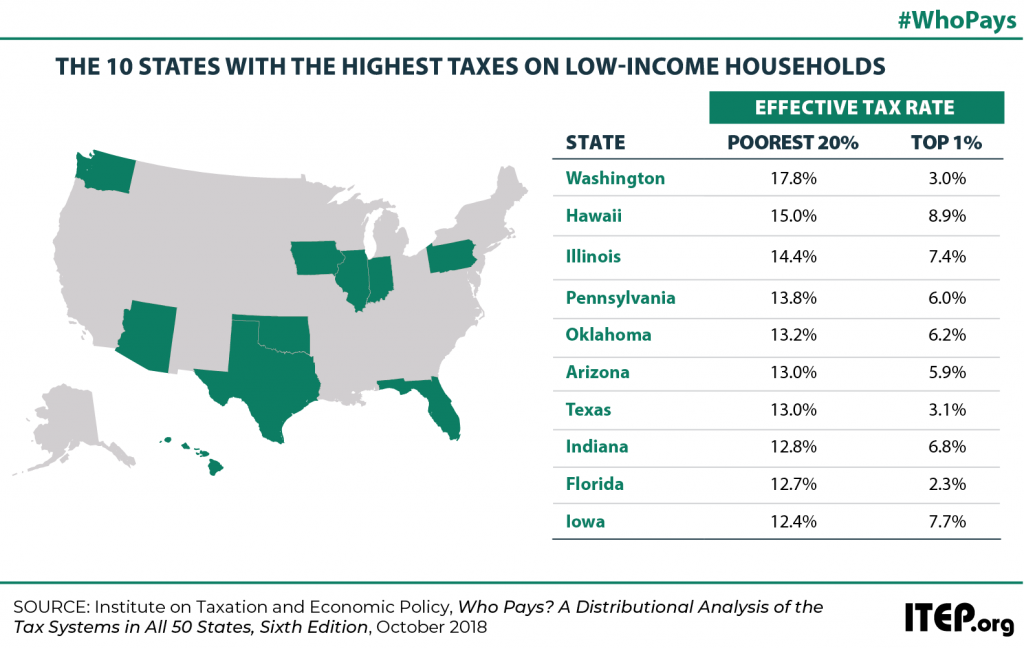
Texas
Texas Property Tax Plan Mimics California’s Damaging Prop 13
December 19, 2025 • By Neva Butkus, Rita Jefferson

This proposal would disrupt the state’s housing market and jeopardize local revenues while doing very little to help workers and families struggling to pay their property tax bills – just as Prop 13 did in California.
State Rundown 12/17: Tax Policy ‘Naughty or Nice’ List Has Late Entrants
December 17, 2025 • By ITEP Staff

With a little over a week left, some states are solidifying their spots on the tax policy “naughty or nice” list.
Every Texan: Texas Taxes Are Upside-Down. Big Tax Cuts Don’t Help.
March 18, 2025
Texas’ tax system is upside-down. When it comes to funding our public services, schools, and state and local governments, Texans with lower incomes are expected to pay more than their fair share. Read more.
Every Texan: Current Border Militarization Operations Are a Wasteful Attempt at Deterrence
January 31, 2025
There is little return to show on past border militarization investments. Beginning in 2021, the Governor launched a multi-year campaign called Operation Lone Star that, in part, allowed his Trusteed Programs office to distribute billions of dollars in grants to once resource-starved border communities. SB 1 prepares to double down on this failed investment with […]
2023’s State and Local Tax Ballot Measures: Voters to Weigh in on Property Taxes, Wealth Taxes, and More
October 24, 2023 • By Jon Whiten

Even in this slow year for candidate elections, the decisions that voters in states and cities make could strengthen or weaken revenue for needs in their communities and could change how taxes are distributed across the income spectrum. In the places where tax fairness is on the ballot, much is at stake.
Every Texan: Proposition 3 Will Maintain Texas’ Extreme Wealth Inequality
October 21, 2023
We all benefit when everyday Texans, regardless of where we live or what we look like, have a fair opportunity to prosper. Contrarily, a state tax system designed to favor the ultra-wealthy undermines all of us. In Texas, the wealth gap is so extreme that 66 billionaires living in the state own more wealth than 70% […]
Washington Examiner: Think tank: Texas Isn’t a Low-tax State if You’re Poor
October 23, 2018
Carl Davis for the Institute on Taxation and Economic Policy: [ M]any states traditionally considered to be “low-tax states” are actually high-tax for their poorest residents. The “low tax” label is typically assigned to states that either lack a personal income tax or that collect a comparatively low amount of tax revenue overall. But a focus on these measures can cause lawmakers to overlook the fact that state tax systems impact different taxpayers in very different ways, and that low-income taxpayers in particular often do not experience these states as being even remotely “low tax.”
CPPP: The Staggering Unfairness of Our State Tax System
October 19, 2018
Here’s one way to think about it: Families at the top of the income ladder receive 20 percent of all personal income in Texas, but pay only 8.5 percent of all state and local taxes. Families at the bottom of the scale receive only three percent of all income, but pay 5.7 percent of all taxes.

ITEP analysis reveals that many states traditionally considered to be “low-tax states” are actually high-tax for their poorest residents. The “low tax” label is typically assigned to states that either lack a personal income tax or that collect a comparatively low amount of tax revenue overall. But a focus on these measures can cause lawmakers to overlook the fact that state tax systems impact different taxpayers in very different ways, and that low-income taxpayers often do not experience these states as being even remotely “low tax.”
